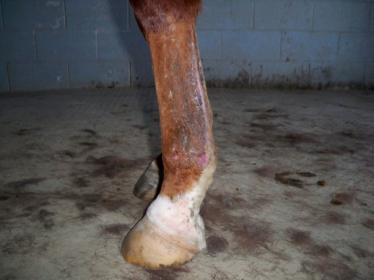It seems like, from my experience, that once horses have had a bad case of scratches or other skin infection that turns into cellulitis, they become hyper sensitive to EVERY. LITTLE. nick/cut/scrape that comes after. The #1 preventative measure I’ve found is to keep the legs clipped (#10 blade; no need to “bald” the area) year-round. That allows you to keep the legs as dry as humanly possible and to catch any problems early, before antibiotics are needed. I also wash legs after every ride/work session (using Nolvasan solution on particularly sensitive horses) and thoroughly towel dry afterwards.
My super sensitive gelding could never be turned out in mud again after the lovely episode pictured below (and this picture was taken AFTER a week of IV oxytetracycline, Bute, and sweat wraps - it was BAD - his legs went from 100% clean to swollen up to the knees and non-weight bearing in less than 12 hours). I also wrapped him any time he was stalled for more than a few hours at a time. Same horse also once got cellulitis, secondary to rain rot, on his poll. That was (NOT) fun to deal with.
Good luck! Cellulitis is a royal pain, and I am now obsessively vigilant about doing everything I can to prevent it.
[ATTACH=JSON]{“data-align”:“none”,“data-size”:“medium”,“data-attachmentid”:10192257}[/ATTACH]


